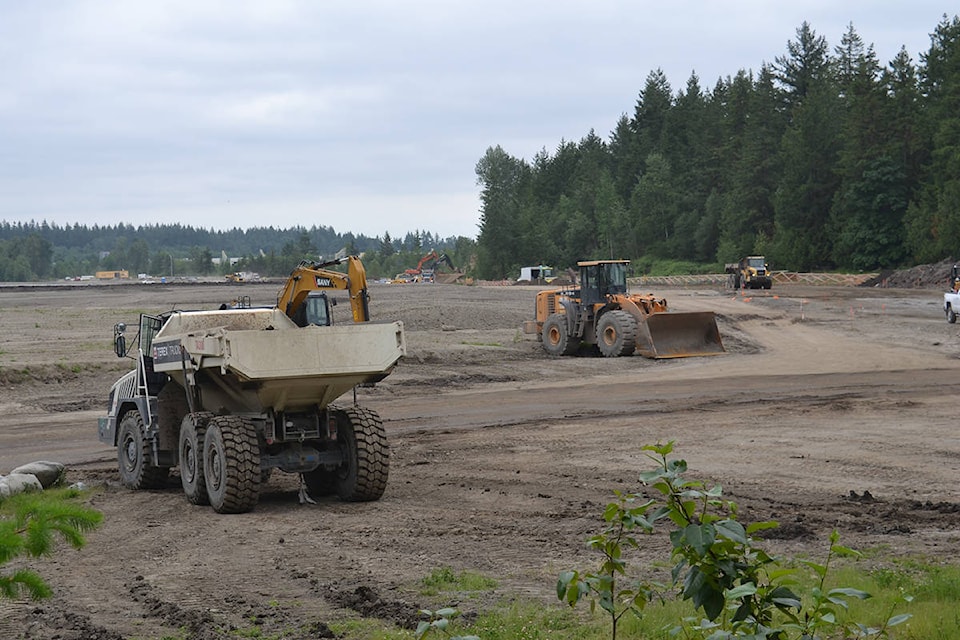Since the new Surrey council took office last October, nearly 50,000 trees have been removed – or approved for removal – by the city to make way for development.
The figure was tallied by Coun. Steven Pettigrew before council received a corporate report regarding construction of roads and water mains on 24 Avenue, 194A Street and 28 Avenue.
“I’m still reeling from the 5,000 non-protected trees that were taken down in this application,” Pettigrew told council Monday night.
“The council approved the destruction, or implemented the future destruction of 35,000 trees (at the) last council meeting, another 5,000 possibly will be done tonight. That’s on top of the few thousand that have come down through the regular applications. So that puts council’s tally at just under 50,000 that have been approved for the axes since we’ve taken office.”
Six minutes after council voted to receive the corporate report, council gave third reading – with all but Pettigrew voting favourably – to a development and rezoning proposal for a multi-building commercial development in Campbell Heights that would require the removal of 523 trees, and – according to Pettigrew – thousands of unprotected trees,
The warehouse development project is located at 19238 and 19290 36 Ave. and 19235, 19259, and 19291 34A Ave.
RELATED: Campbell Heights development to see removal of more than 500 trees
According to the development proposal, none of the trees on the lot can be saved. The applicant will be required to plant trees on a one-to-one replacement ratio for alder and cottonwood trees, and a two-to-one replacement ratio for all other trees, which equates to 1,053 replacement trees.
However, only 186 replacement trees can be accommodated, and the developer will be required to make a cash-in-lieu payment of $346,800, representing $400 per tree, to the City Green Fund.
“This application will destroy two-and-a-half times the number of trees that were cut down for the road through Hawthorne Park and remove up to another 5,000 unprotected trees from the canopy,” Pettigrew said before the vote. “I continue to see thousands upon thousands of trees being taken down and our tree canopy decreasing. I will not be supporting this application.”
RELATED: Surrey residents mourn tree loss in Hawthorne Park
Pettigrew told council that he would hope to see, at some point in the future, a way the city can balance the loss of trees, perhaps through the tree protection bylaw or the biodiversity conservation strategy.
“Right now we’re in the extreme end of having tree loss.”
Last week, Couns. Laurie Guerra, Allison Patton and Pettigrew joined Little Campbell Watershed Society’s David Riley and Semiahmoo First Nation band council on a tour of the Little Campbell River watershed.
Last week, Riley told Peace Arch News that the society is trying to interest council in starting some kind of compensation program to deal with the loss of not only individual trees, “but essentially mature forests,” due to development.
“We’re calling this an ecological services compensation program. It’s going to be a long and difficult discussion, because, one, how do you do this without penalizing owners who have not cut all of their trees down?” Riley said.
Riley said trees provide a number of benefits, such as helping reduce greenhouse gases, providing habitat for animals, and improving human health.
The trick, Riley said, is determining what ecological services residents want from trees, and how many treed ares are required to service that.
“Do we just want trees in parks and trees along the road? I think that’s what people need to do, join that conversation,” Riley said.
Riley said there’s “no point” in fighting individual developments, including ones that involve total clear-cuts. The focus, he said, should be on policy.
“What you want to be talking to your councillors about is, we want to be talking about this in terms of a Surrey-wide policy. As we go along, what kind of ecological services do we want to be getting from trees?”
He said the Little Campbell Watershed Society’s stance on the issue is that tree planting should be focused in riparian areas.
“Where we have opportunities to plant tens of thousands of trees. We could be planting a lot of trees. Street trees is probably not the best opportunity to offset the loss of ecological services. We believe there are a lot of opportunities,” he said.
Riley said he believes that the current council is willing to listen to concerns about the city’s trees, and “we certainly have staff that want to engage in that.”
But, he said, it’s up to the residents to tell councillors that that’s the conversation they want to have.
He listed a number of groups that have focused discussions on the city’s tree canopy, including the Ocean Park Beautification Committee, White Rock and Surrey Naturalists Society, and watershed groups.
“You’ve got all these groups and they all want to discuss it. I think it has to become more of a public discussion, otherwise it just becomes a picture in the Peace Arch News and people are upset. We just go on with that, year-after-year, and at the end of the year, we tally how many trees came down.
“If people want change from that, they have to talk to their council.”
